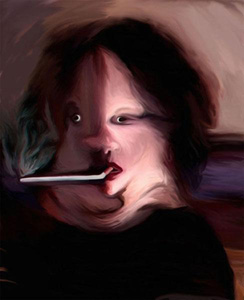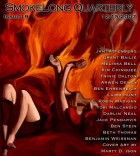This is an excerpt from your forthcoming book, correct? Tell us about the longer version. Are Candy and ESP the central characters?
Yes, it’s from my book-in-progress, “Sweet Tomb.” Candy is the protagonist, a candy-addicted witch who lives in the forest but after a series of losses and tragedies decides to venture out into the urban world to meet people. So ESP is one of these characters, and this is the only chapter in which he gets a chance to work his psychic magic. From here, in the piece, she meets Death at the local bank. Death is a female monster with a shoe fetish who becomes her girlfriend for better or worse. The book is about the witch’s journey, and following this section, Candy’s life goes downhill in a major way though there is much transformation that takes place.
While discussing this piece, we, the editors wondered—is Candy truly a witch or is she a symbolic character?
In “Sweet Tomb,” she is a real witch. It’s a fairy-tale though I do try to make her as humanistic as possible, insofar as she “exists” in our real world, and interacts with people in cars, banks, etc. as in “Killer Pair.” Candy was born into a long line of witches, and feels cursed by her lifestyle. She tries to fight it, but has to eventually come to terms. She gets sick if she tries to eat anything but sweets. I modeled her after the witches in Hans und Grete and Baba Yaga. She has witchy powers, and attempts to use them with varying degrees of success. She has good and evil embedded within her soul, and struggles to balance them. So, although she is not a real witch in this world with whom I interviewed to write the book, she is a real witch within the book’s fictional framework
You have a zine called Werewolf Express. Tell us about it.
I made Werewolf Express for a 2005 exhibit I was in at the Yerba Buena Center, “The Zine Unbound: Kults, Werewolves, and Sarcastic Hippies.” I made the printed book with the help of YBCA and Peres Projects and then curated a section of the show based on my contributors. It is all about shapeshifting and werewolfism. I collected massive amounts of material from friends and artists, assembled it while living in Berlin for the summer, then designed all the spreads including lettering, etc. My zines are editing projects that also function as art projects, as I do sections in them as a contributor as well. Before that I did Touch of Class, about unicorns. And now I’m doing another “secret” issue, which will head a compilation I’m working on to collect all the zines together into one volume since they’re all out of print. That will be published and released in Fall 2008.
I want to know more about DEAR NEW GIRL OR WHATEVER YOUR NAME IS. How did you get these confiscated high school notes?
I taught high school English, mostly 9th and 12th grade. I subbed for only a few teachers repeatedly, had many of the same classes continually, so I really got to know the kids I worked with. Nevertheless, kids write massive amounts of notes, and I love this about teen culture. I told them that if I caught them passing notes, the notes were going into my collection. And I still caught tons of them! I also asked students whose art I admired to draw me pictures for my collection if they were done with their assignments so I have a lot of amazing artworks that weren’t even reprinted in DNG. I treasure my archive. I love how sexually explicit the notes are, and it astounds me how bonkers students get sitting in class cooped up trying to absorb basic information. I didn’t really blame them for writing notes, honestly, I’d write notes too if I were them. There are so many psychotic high school teachers, and I felt bad for the kids who had to suffer under their wrath. But I had to set limits, let them know that note-passing was disrespectful, thus the punishment was the embarrassment in knowing I’d be reading their private jokes. I’m a tough teacher all in all, even with college level students, but I do let students know I’m on their side and appreciate their perversities.
The book doesn’t show that many of the notes reproduced. We commissioned artists to reinterpret the notes, to give it a twist from say, Found magazine, which I also love. So DNG was more of a curated editing project. I broke my notes into five main categories, like SEXUAL CURIOSITY, LOVE/BROKEN HEART, WEAPONRY, then from there we chose our favorite notes, then passed on those notes to artists who had free reign to make work based on the content. It was a round table process, the piles of paper really built up!
SLQ completed issue 18 at the close of summer and launched this issue, 19, on the threshold of winter. During the three months in between, the crops were harvested, the leaves fell, the rain returned, temperatures dropped, darkness lengthened. Death in increments. How does the turning of the seasons affect your “muse,” your inspiration?
I’ve never lived with four seasons, only two, rainy and dry. In LA, in chapparal, the landscape is mostly dry, and it rains a lot for about three months a year. So during those Winter months, I hike a lot and mushroom hunt with my husband, painter Matt Greene. We have good rain gear so the second the rain starts falling, we’re out the door. Then in Spring, I wildflower hunt as well, which provides me great inspiration. I like returning to the same spots annually to see what specimens will reappear under various conditions. I have spots I’ve been checking since I was a kid. But this week, I moved to Brooklyn, where it’s currently snowing! So the seasons will hit me hard, I’m excited to say. Will have to learn a whole new flora and fauna, and new mycology. I’m really looking forward to delving into the world of ferns, which are also what Oliver Sacks loves, apparently. We kept our jeep so we can take trips up into the mountains frequently. Wilderness inspires me immensely. I mostly need breathing room and opportunities to check in on plants and animals. But I love cities, so I’m not quite the mountainous hermit type.


